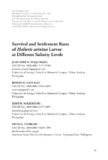Optimum low salinity to reduce cannibalism and improve survival of the larvae of freshwater African catfish Clarias gariepinus

Quan điểm/
Request this document
Ngày
2017Tác giả
Page views
296metadata
Hiển thị bản ghi đầy đủ mặt hàngCited times in Scopus
Share
trừu tượng
The freshwater African catfish Clarias gariepinus is carnivorous and cannibalistic even during the larval and juvenile stages and this behavior causes economic losses in aquaculture. This study examined for the first time the effect of salinity on cannibalism, survival, and growth of African catfish larvae in the hatchery. Larvae (4 days old, median 7.8 mm TL, 2.8 mg BW) of the African catfish were reared for 21 days at nominal salinity 0, 1, 2, 3, 4, 5, 6, and 7 ppt. After 21 days, they grew to 10–39 mm (median 22 mm) and 10–490 mg (median 90 mg), with no significant difference by salinity treatments. Survival ratios were similarly low (24–31%) at 0, 1, 3, and 7 ppt and significantly higher (49–55%) at 2, 4, 5, and 6 ppt. Cannibalism was significantly lower, 15–30% at 4–6 ppt, than the 40–50% at 0–3 and 7 ppt. Size variation was lower at 4–6 ppt and higher at 0–3 and 7 ppt. We recommend hatchery rearing of African catfish at the optimum low salinity of 4–6 ppt rather than in full fresh water at least up to 21 days. This rearing method fosters larval welfare and improves hatchery production.
Suggested Citation
Kawamura, G., Bagarinao, T., Yong, A. S. K., Sao, P. W., Lim, L. S., & Senoo, S. (2017). Optimum low salinity to reduce cannibalism and improve survival of the larvae of freshwater African catfish Clarias gariepinus. Fisheries Science , 83(4), 597-605. https://doi.org/10.1007/s12562-017-1088-y
Chủ thể
inland water environment  ; juveniles
; juveniles  ; larvae
; larvae  ; salinity
; salinity  ; aquaculture
; aquaculture  ; salinity effects; survival
; salinity effects; survival  ; rearing techniques
; rearing techniques  ; cannibalism
; cannibalism  ; predators
; predators  ; growth
; growth  ; carnivorous animals
; carnivorous animals  ; hatcheries; fresh water
; hatcheries; fresh water  ; methodology
; methodology  ; ratios; aggressive behaviour
; ratios; aggressive behaviour  ; osmoregulation
; osmoregulation  ; freshwater catfish
; freshwater catfish  ; Size variation; Clarias gariepinus
; Size variation; Clarias gariepinus 
 ; juveniles
; juveniles  ; larvae
; larvae  ; salinity
; salinity  ; aquaculture
; aquaculture  ; salinity effects; survival
; salinity effects; survival  ; rearing techniques
; rearing techniques  ; cannibalism
; cannibalism  ; predators
; predators  ; growth
; growth  ; carnivorous animals
; carnivorous animals  ; hatcheries; fresh water
; hatcheries; fresh water  ; methodology
; methodology  ; ratios; aggressive behaviour
; ratios; aggressive behaviour  ; osmoregulation
; osmoregulation  ; freshwater catfish
; freshwater catfish  ; Size variation; Clarias gariepinus
; Size variation; Clarias gariepinus 
Bộ sưu tập
- AQD Journal Articles [1240]
Related items
Showing items related by title, author, creator and subject.
-
Survival and settlement rates of Haliotis asinina larvae at different salinity levels
Maquirang, Jean Rose H.; Caturao, Romeo D.; Maquirang, Jessy H.; Pedroso, Fiona L. (IAMURE Multidisciplinary Research, 2013)The study was conducted to determine the optimum salinity levels (24 ppt, 28 ppt, 32 ppt, 36 ppt and 40 ppt) for the survival and settlement rates of H. asinina in a complete randomized design with three replicates each. ... -
Growth response of Nile tilapia fry to salinity stress in the presence of an ‘internal reference’ fish
Basiao, Zubaida U.; Eguia, Ruel V.; Doyle, Roger W. (Blackwell Publishing, 2005)Growth of three strains of Oreochromis niloticus L. fry exposed to salinity stress in the presence of an internal reference fish were compared. The Central Luzon State University (CLSU) strain was obtained from the Freshwater ... -
Impact of AMPEP on the growth and occurrence of epiphytic Neosiphonia infestation on two varieties of commercially cultivated Kappaphycus alvarezii grown at different depths in the Philippines
Borlongan, Iris Ann G.; Tibubos, Keneth R.; Yunque, Dianne Aster T.; Hurtado, Anicia Q.; Critchley, Alan T. (Springer, 2011)Two varieties of the carrageenophyte Kappaphycus alvarezii (Tungawan, TUNG; and Giant tambalang, GTAM) from Zamboanga Sibugay, Philippines were used to test the efficacy of Acadian Marine Plant Extract Powder (AMPEP) as ...



